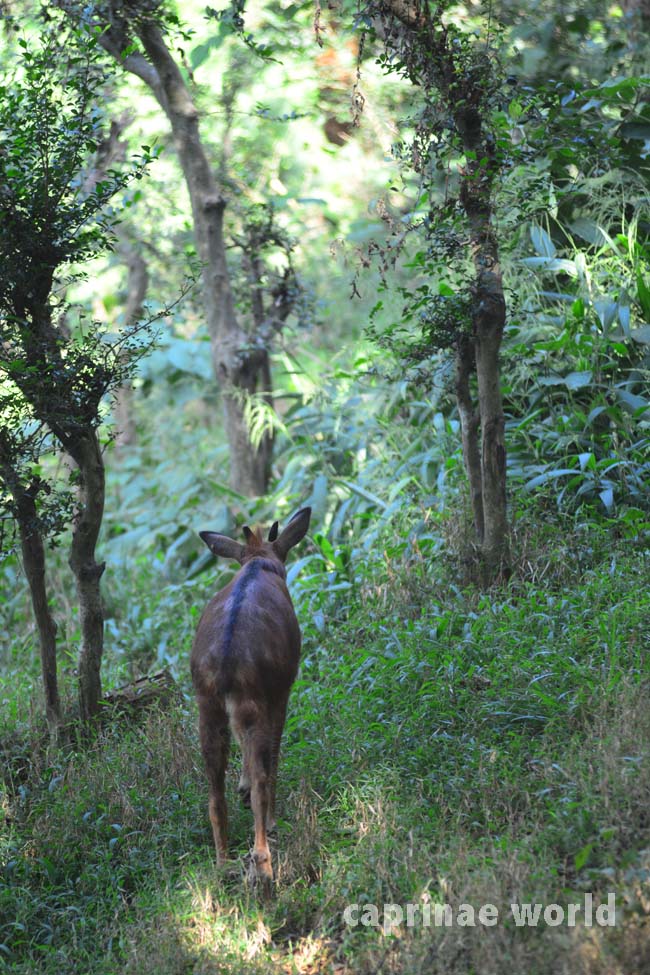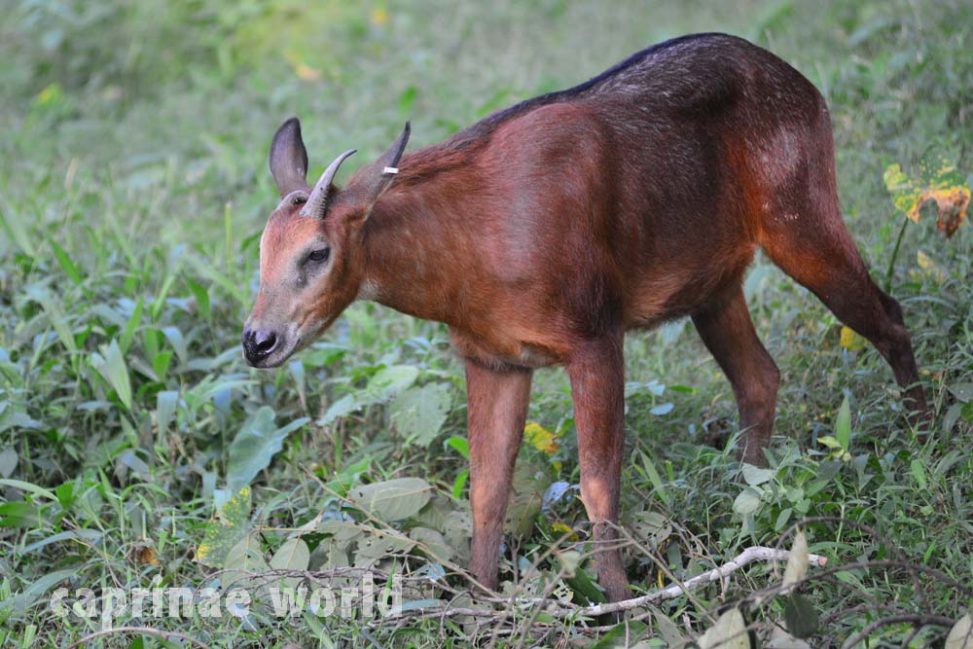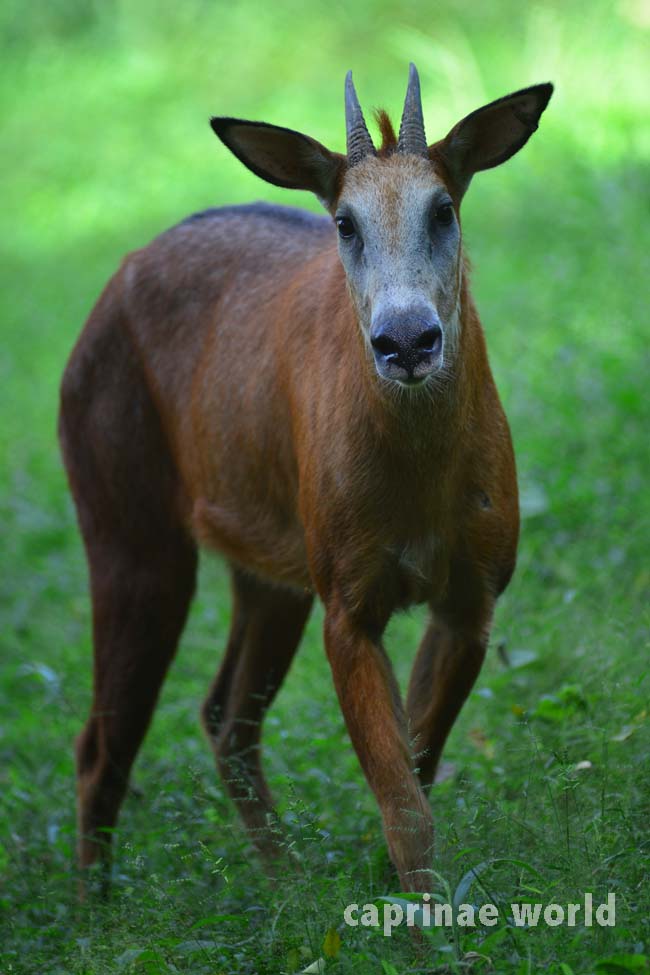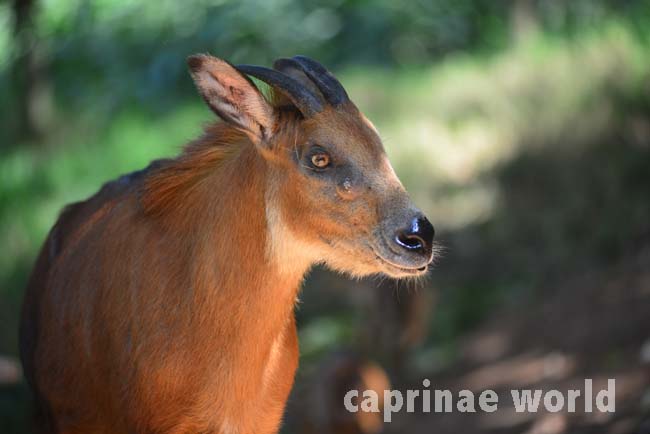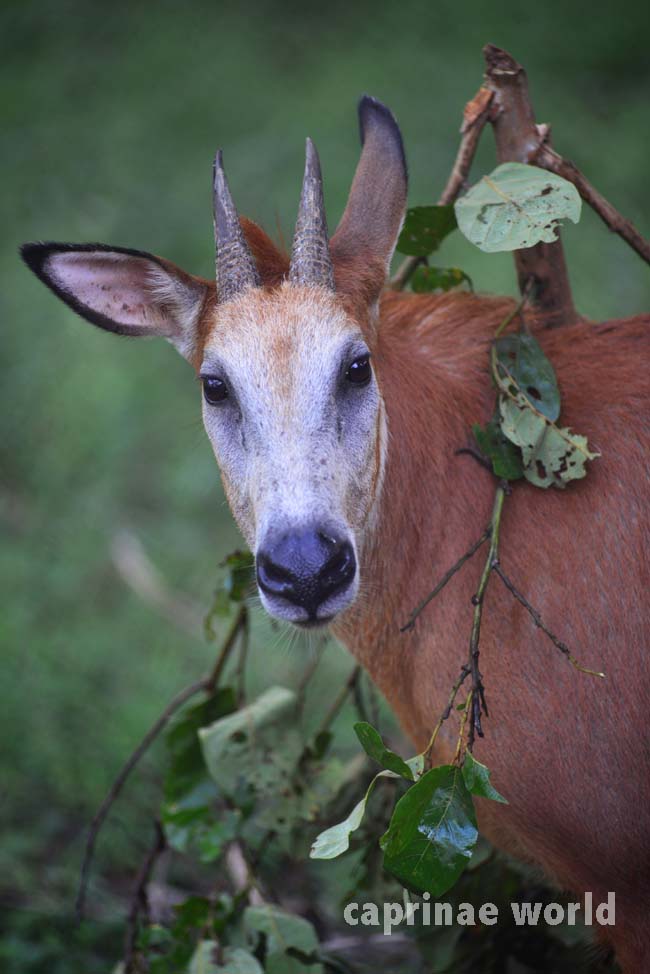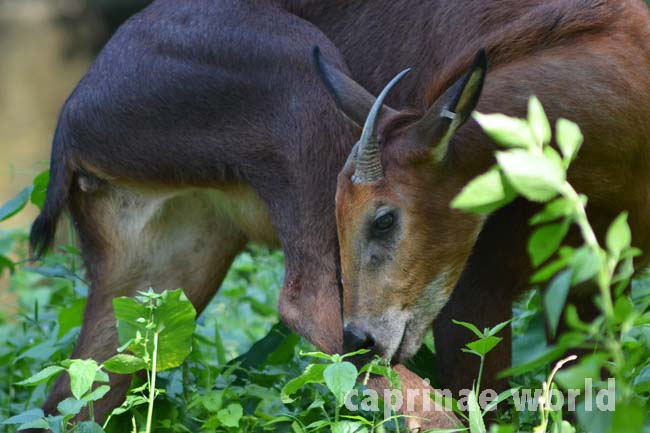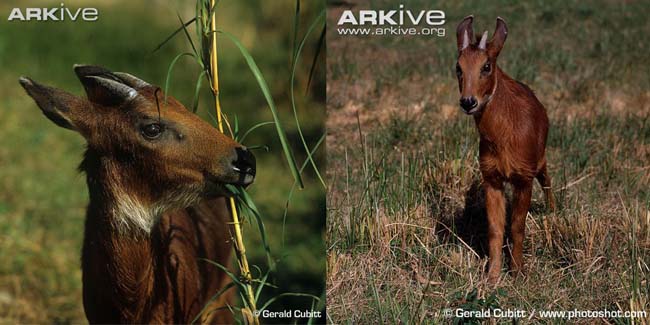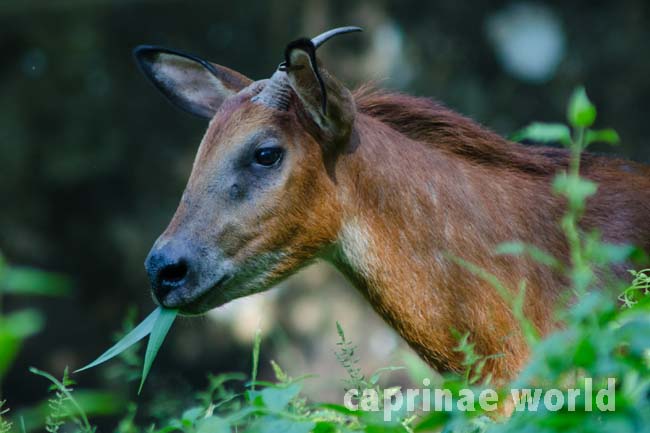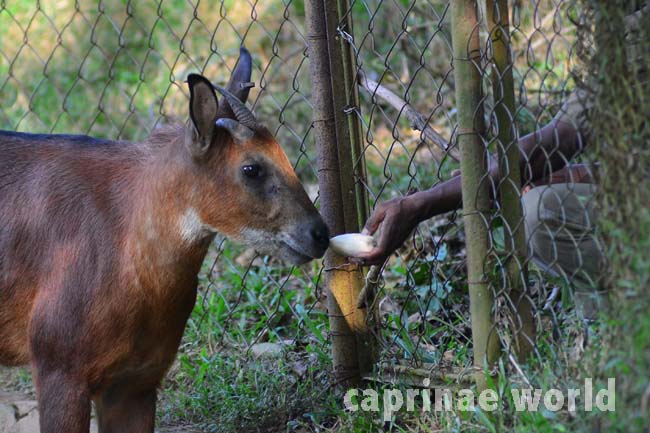The Red Serow is almost a mythical animal. Very little is known. And it is definititly a candidate for a possible taxonomic split in the future.
Note! All photos in this chapter are depicting „Light Red Serow“ alias „Assamese Red Serow“
Names
English: Red Serow (2), Burmese Red Serow (3), Arakan Serow (5)
French: Saro carmin, saro rouge (5)
German: Roter Serau (5), Arakan-Serau (9)
Spanish: Sirao rojo (1), Serau rojo, serau de Birmania (5)
Synonym: Capricornis sumatraensis Blyth, 1863 ssp. rubidus (2)
Taxonomy
Capricornus rubidus Blyth, 1863 (2, 3)
Type locality: Arakan Hills, Rakhine State, east of Bay of Bengal (1)
The taxonomy of serows in general is not completely resolved. Descriptions, range maps, and assessments of conservation status in the literature vary because sources differ on nomenclature and specific/subspecific status of the various taxa. (2)
There is two forms of Red Serows: a darker red-colored form and a lighter red-colored. The darker form has a black hair base, the lighter form gets its lighter pelage from hair with a white base. The darker form is sometimes referred to as the „true“ Red Serow or Burmese Red Serow (2), the lighter colored form as the „Assamese Red Serow“. (1) The „Dark Red Serow“ is mainly known from Northern Myanmar, the „Light Red Serow“ from Northeast India and Western Myanmar (Red Serow from Bangladesh are presumably also light-colored). However the type locality of the „true“ Red Serow (dark form) is from the Arakan Hills in Western Myanmar, which is mainly within the range of the Light Red Serow. That is contradictory!
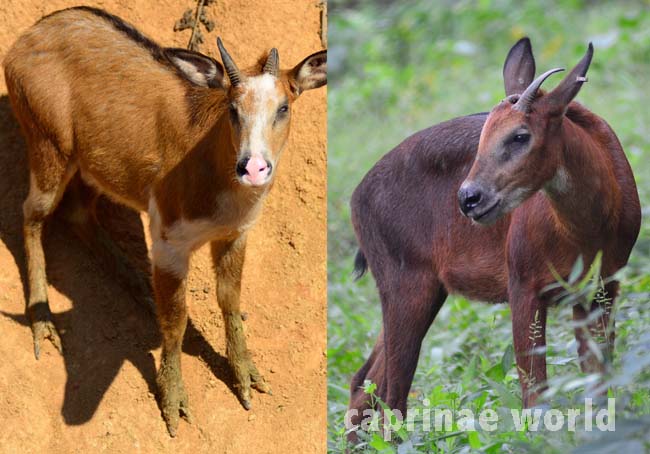
Two „Light Red Serows“: left one in bright sunlight, right one in the shade. This depiction can give an impression of how Light- and Dark Red Serow could differ in pelage color. To date (2017/04) a photo of a live „true“ Burmese Red Serow is not available.
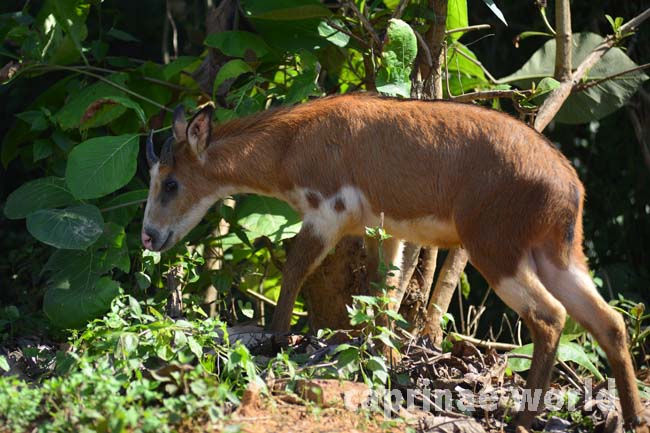
This male „Light Red Serow“ shows unusual white spots. Presumably this can be ascribed to Vitiligo, a long term skin condition characterized by patches of the skin losing their pigment. Photo taken 2016 at Dimapur Zoo, India
The Red Serow was formerly also categorized as a subspecies of the Sumatran Serow (Capricornis sumatraensis rubidus) (3) or as a red form of the Himalayan Serow (Capricornis thar). (2)
Similar species
The Red Goral is partially found in the same region as the Red Serow, but is smaller and more compact, and lacks the Serow’s neck mane. Gorals also have smaller horns (5), but this feature is probably not well-suited for a distinction in the field.
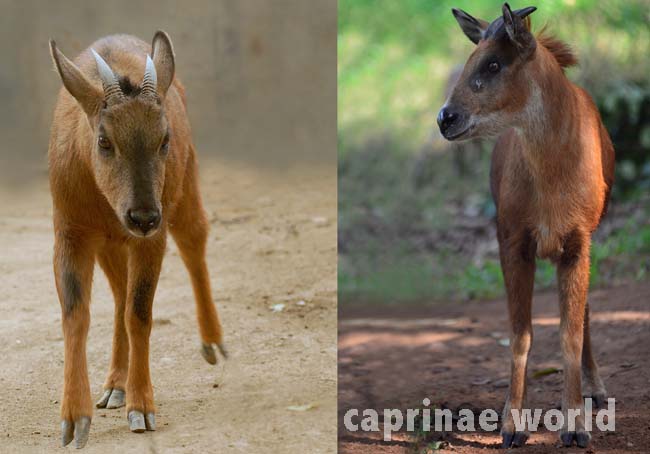
Red Goral, Zoo Bejing (left), Assamese Red Serow, Zoo Guwahati (right). Note the black markings on the Goral’s front legs and nasal bridge and the conspicuous preorbital gland in the serow.
Distribution
The Dark Red Serow is known from northern, and perhaps western Myanmar (Grubb, 2005). Specimens from Kachin state in the north of Myanmar are clearly this species. The type locality is from the Arakan Hills, Western Myanmar. However many of the type localities from that time period (around 1863) are wrong and this may be one of them. Little survey work has been done in the region of the type locality. (2)
Locations of Burmese Red Serow
|
Burmese Red Serow specimens seen by Groves and Grubb (2011) (4)
Rabinowitz (1998) examined two Red Serow heads from the villages of Tashuhtu and Tazungdam in Hkakabo-Razi Protected Area, Northern Myanmar. He also obtainend a skin from the Putao market (Northern Myanmar). In Shangong, northwest of Putao, local hunters claimed that only red serow occured in the forests (Rabinowitz 1998). Duckworth and Than Zaw (2008) state that records and specimens from Kachin state in the north of Myanmar are clearly rubidus. (1) |
The Distribution of the „Assamese“ Red Serow has it’s own story
Boundaries of Indian states have shiftet in the past. What was once Assam, is no longer Assam today. Therefore the distribution area of the Light Red Serow is sometimes underestimated. For example the Naga Hill district – with the Naga Hills as one locality, where the Light Red Serow has been confirmed – was made part of Assam province in 1912. Following the Partition of India, it was merged with the Tuensang Division to create the state called Nagaland in 1963. (6) Other areas were renamed as well (see below).
Groves and Grubb (2011) list the following localities for the Assamese / Light Red Serow, some of which have probaly not fully appreciated
|
Then there is recent proof for localities of the „Light Red Serow“ through photos that are available online (2017/04)
|
Conservation India has published a photo of a „Red Serow“, clearly showing white hair base on back and flanks, from Hmuifang, Mizoram. A camera-trapping exercise in Arunachal Pradesh’s Namdapha Tiger Reserve has yielded a Light Red Serow that was accidentally identified as a Red Goral. 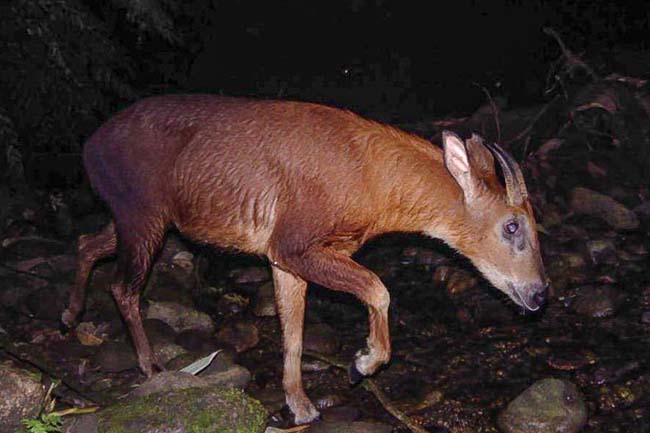 Photo: Aaranyak, Panthera and Namdapha Tiger Project
|
The population in Bangladesh (Chittagong Hills) is most likely of the Light Red Serow type. It is supposed to be rare in Bangladesh, and is confined to a few scattered populations east of the Jumuna River in the border regions of Chittagong, Chittagong Hill Tracts, Cox’s Bazar and Sylhet (Khan 1985). (1)
Summary „Distribution Light Red Serow“: The „Assamese Red Serow“ has a much wider distribution than previously assumed. It has been reported from the Indian states of Assam, Arunachal Pradesh, Nagaland, Meghalaya, Mizoram, Tripura, Western Myanmar and probably Bangladesh.
Red Serow also overlap with other serow species/subspecies: U Tun Yin (1967) recorded black serow with red legs (C. milneedwardsii?) from Mogok, Mongmit, Maymyo, and Tharrawaddy. And he has seen black serow with black legs (C. sumatraensis?, C. maritimus?) at Wetwun, Maymyo, and other locations in the N Shan States, Eastern Myanmar. (4) This view is partially confirmed by Duckworth and Than Zaw (2008): The Burmese Red Serow may overlap with C. milneedwardsii which extends through most of the Shan States (Eastern Myanmar) and Pegu (Bago) Yoma (Central Myanmar) at least as far west as the Ayeyarwady river. (2)
General description – Burmese Red Serow
length / head-body: 140-155 cm (3); smaller than the Chinese Serow (1)
shoulder height: 85-95 cm (3)
pelage characteristics: reddish-brown, short hairs with black hair bases (3). There are variations in some animals, where individuals are darker, almost black, with a reddish tinge. (1)
dorsal stripe: blackish, extends to the tip of the tail (1)

Seven year old, female „Assamese Red Serow“ from Guwahati Zoo. Note the black dorsal stripe merging into a red mane.
face: has no distinctive markings, but large preorbital glands are present in front of the eyes (5)
throat patch: on upper part of throat (1); white or creamy red (3); chin and lower jaw: some whitish hairs (1); white or creamy red (3)

2,5 year old, female Assamese Red Serow from Guwahati Zoo: Note the black area around the eye and bicolored tongue.
mane: dark red (3); can be erected when excited (5); smaller than in the Chinese Serow (1)
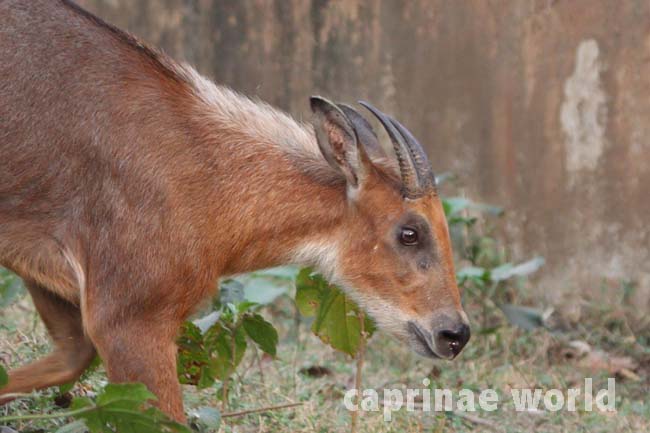
Apparently the „Assamese Red Serow“ also comes with a white mane. However out of seven specimens seen, only one had a white mane. So far I found no evidence that mane color correlates with age. Photo: Brent Huffman – www.ultimateungulate.com
ears: long, pointed (1)
underparts: white (1, 3)
legs: reddish (3); white hair on the fetlocks (5)
tail: bushy (5)
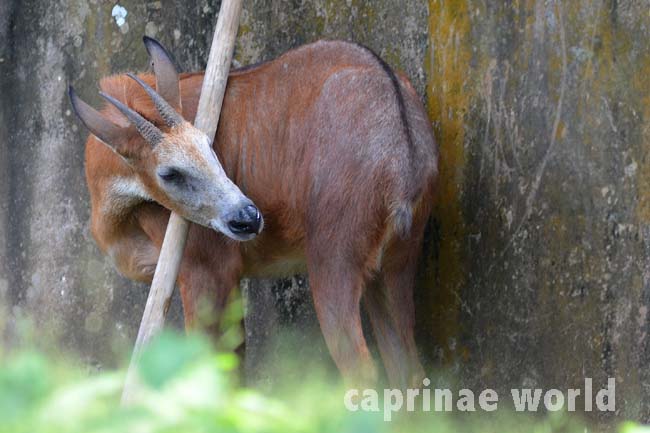
The tail of this specimen is very inconspicuous: short, ending with a grayish tuft. The dorsal stripe terminates at the base of the tail
diploid chromosome number: no data (1)
Horns
conical, short, backward-curving; longer and thicker in males (5); show narrow horizontal ridges. It appears that the Red Serow has on average somewhat shorter horns than the Himalayan Serow. Horn length is around 20,3 cm. Lydekker (1913) mentions a head collected in the Arakan Hills of Burma (BMNH Cat. Nr. 12. 10. 31. 36. Skull, with horns. Arakan; collected by J. D. Mercer) as being the record at that time, attaining a length of 21.4 cm and a circumference at base of 12.7 cm. (1)
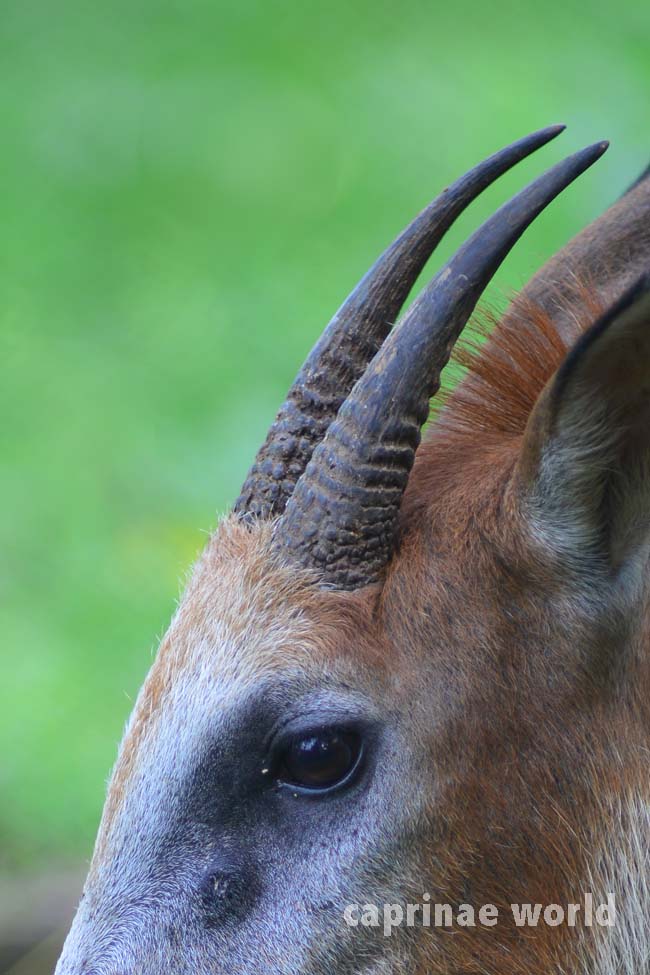
Horizontal ridges are clearly visible in this 2,5-year old, female Assamese Red Serow. However age determination based on the horns seems not possible.
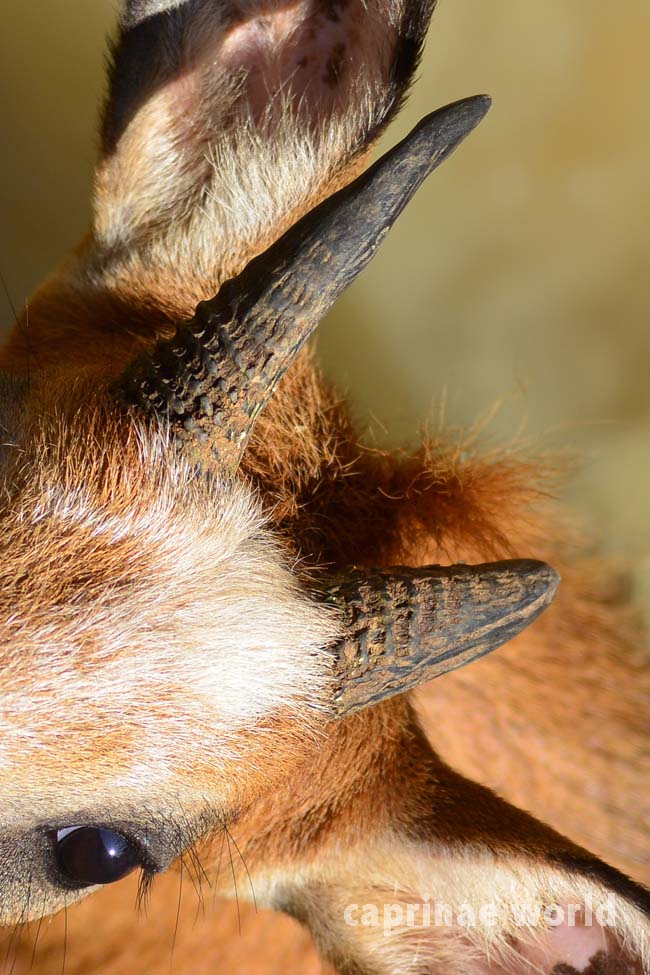
Horns of a male „Light Red Serow“. Horizontal rings at the base of the right horn (left-hand side) partially „dissolve“ to build disconnected rings of lofty dots.
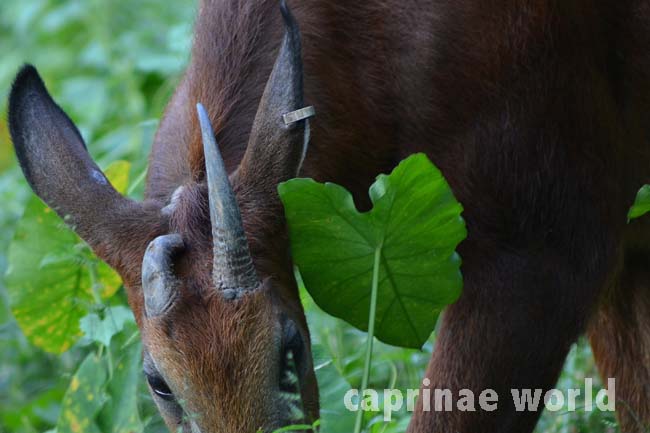
2,5-year old Assamese Red Serow with deformed right horn – cause of deformation not known
What does a Burmese („Dark“) Red Serow look like?
You still have to wait to find that out!
Nobody really knows how it looks like! There are a few images that you can find in a few books (1, 3, 5) and on the internet, but almost all of them are depicting the so-called „Assamese Red Serow“. There are literally just two photographs taken by Gerald Cubitt, that you find on Arkive or at photoshot.com. The pelage color of the depicted animals is dark reddish-brown. And indeed, a Burmese Red Serow could look like this. But!
The photos were taken at Manipur Zoological Garden, Imphal, Manipur, India. But there is not a single location known in India, where a „Burmese Red Serow“ specimen has been verified. And it is very unlikely that Maninpur Zoo has imported Red Serows from Myanmar, the only country harbouring Burmese Red Serow. Therefore it is doubtful that the animals at Manipur Zoo were Burmese Red Serow (Manipur Zoo no longer keeps Red Serow. Dominique Brugiere: pers. comm., 2017/04). Hence, the world still has to wait for somebody to take the first photograph of a „true“ Burmese Red Serow!
Habitat
Hilly habitats in tropical and subtropical forest (3)

View from a road near Dimapur, Northeastern India, looking towards the border with Myanmar. There are still large tracts of forests. However many people inhabit these forests who depend on its resources – including serows.
Mortality / Predators
leopard, dhole, eagles (5)
Food and feeding
no published information available, but probably browse is a major component of the diet (3)
Plant species fed at two Indian Zoos (pers. comm. with zookeeper / curator):
|
Guwahati Zoo: Jackfruit (Artocarpus heterophyllus), banana, carrot, chaana (chickpeas), Lesera mah (Vigna unguiculata – Black–eyed pea); Fig leaves (Ficus sp.) are the preferred food. Dimapur Zoo: charcoal-tree or pigeon wood (Trema orientalis), mulberry, banana, pumpkin, squash, other seasonal vegetables |
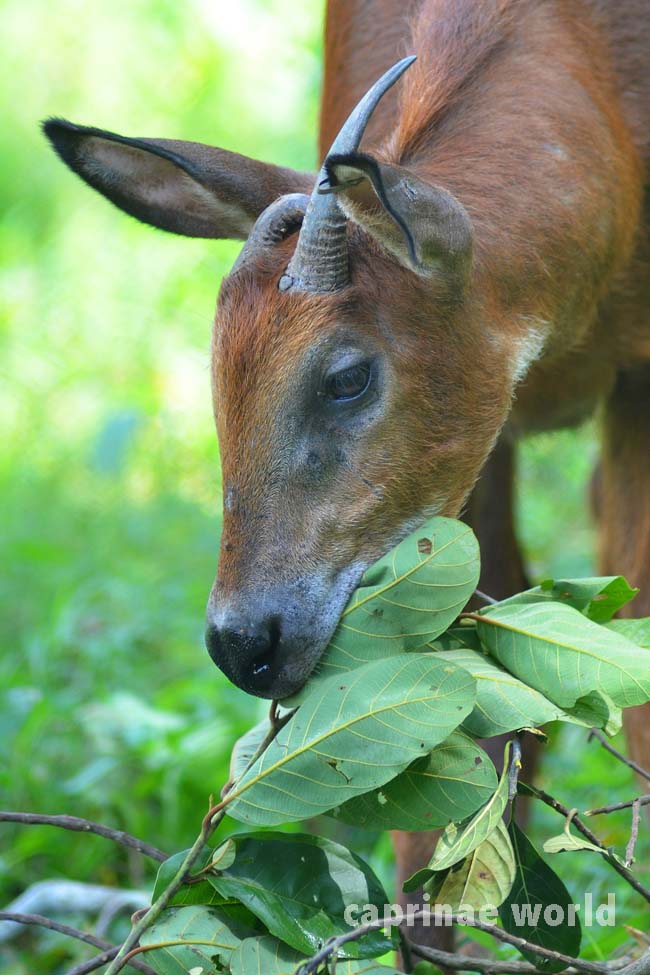
Assamese Red Serow feeding on leaves (Ficus sp.?). The animal is a 2,5 year old female from Guwahati Zoo.
Breeding
no information available, but probably similar to other serows, with a gestation of about 210 days, followed by birth of a single young, rarely twins. (3)
Activity patterns
no information available, but other serows are most active at dawn and dusk, and spend the rest of the day in thick vegetation. (3)
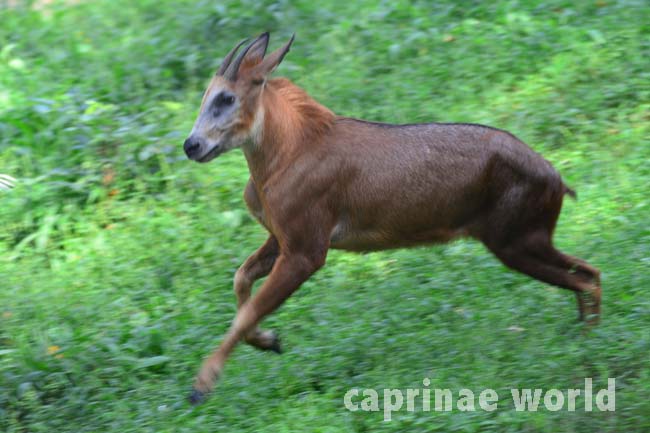
Derived from their natural habitat in dense subtropical and tropical forests it can probably be assumed that Red Serows are no endurance runners. If startled they are agile animals.
Movements, home range and social organisation
no information available, but related serows are territorial, typically moving along beaten paths that they create through their territories. (3)
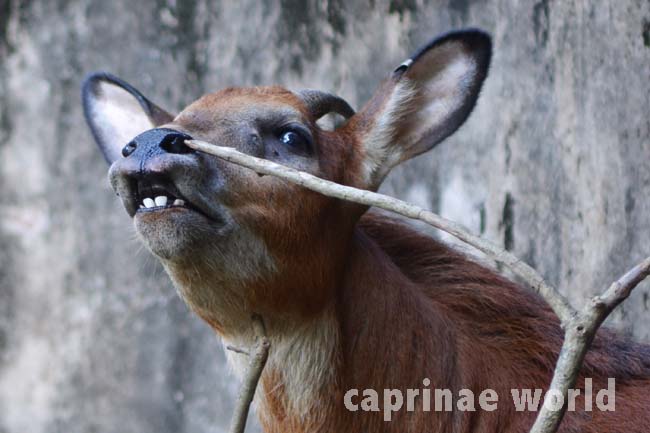
2,5-year old female Assamese Serow sniffing the end of a dead branch that could have been marked by a conspecific. Olfactory communication is known to play an important role in both sexes of the Japanese Serow. Most likely it is important for Red Serows as well.
Threats / Conservation Status
Classified as „Near Threatened“ on the IUCN Red List. (2).
This Red List assessment is based on the best available information – which is not much. Therefore it contains considerable uncertainty. However, the species is probably declining due to over-hunting, like Capricornis milneedwardsi, probably at a rate of less than 30 percent over three generations, taken at 21 years. The true status of the species may be better or worse than this. (2)
The threats to this species are not known, but there is significant hunting of other large mammals in the area. The serow in Myanmar is one of the most heavily traded species in the local trade. Every market surveyed by TRAFFIC in Myanmar in 2006 had Serow, and in most markets, this was the most commonly observed species, with the bulk of the parts observed being horns and heads. Many of these markets are situated on the Myanmar-Thailand border and dealers claim that all buyers in these border markets come from Thailand, indicating a blatant disregard for both national legislation and CITES. Serows are protected throughout Southeast Asia by law, but protecting this species on the ground does not appear to be a priority in many countries.
Serow are very heavily hunted in Myanmar, with meat usually being consumed locally, but parts, including the forelegs, heads, horns and fat from the stomach region being the most sought after for use in traditional medicines. These parts are rendered down and the oil is sold in small bottles. According to dealers, this oil is applied externally to treat skin ailments and joint problems. Horn tips are also exported from Myanmar to Thailand to be attached to the spurs of fighting cocks (this is believed to give them more power).
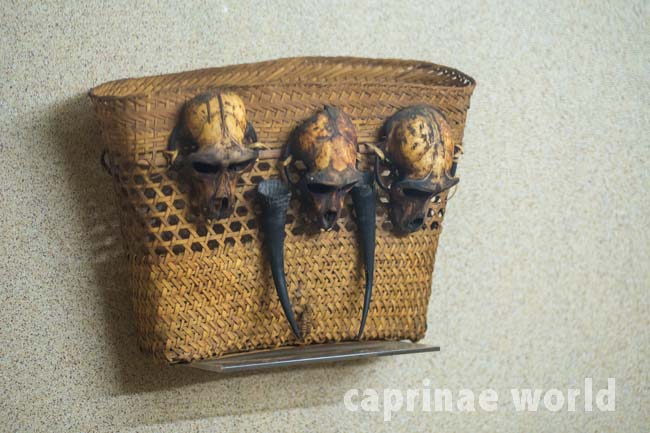
Hunting has a long tradition in India’s Northeast states. Warrior’s Victory Basket, Konyak people, Nagaland, India. The basket is decorated with three monkey sculls and a pair of serow horns. Photo taken at Kohima State Museum
In 2006, interviews with dealers in border markets and markets in the centre of Myanmar, revealed that in all areas surveyed, Serow are apparently in decline. Hunters stated that they were having to travel further to get serow, and that they were, in many locations, becoming scarce.
There is an urgent need to survey this species‘ habitat to determine the range limits, population, and threats. Measures also need to be enacted to prevent hunting of the species. It is expected to occur in several protected areas, but this requires confirmation. (2)
Trophy hunting
does not take place (1)
Ecotourism
does not take place
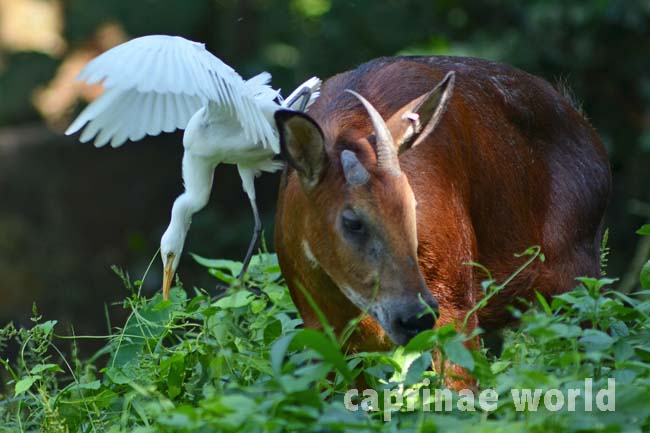
Literature Cited
(1) Damm, Gerhard R. and Franco, Nicolás, 2014: The CIC Caprinae Atlas of the World – CIC International Council for Game and Wildlife Conservation, Budakeszi, Hungary in cooperation with Rowland Ward Publications RSA (Pty) Ltd., Johannesburg, South Africa.
(2) Duckworth, J.W. & Than Zaw. 2008. Capricornis rubidus. The IUCN Red List of Threatened Species 2008: e.T3815A10102774. http://dx.doi.org/10.2305/IUCN.UK.2008.RLTS.T3815A10102774.en. Downloaded on 19 April 2017.
(3) Wilson, D.E. and Mittermeier, R.A. [eds], 2011: Handbook of the Mammals of the World. Vol. 2. Hoofed Mammals. Lynx Edicions, Barcelona.
(4) Groves, Colin and Grubb, Peter, 2011: Ungulate Taxonomy. The John Hopkins University Press.
(5) Castelló, José R., 2016: Bovids of the World – Antelopes, Gazelles, Cattle, Goats, Sheep, and Relatives. Princton University Press.
(6) B. Datta-Ray, S. P. Agrawal (1996). Reorganization of North-East India since 1947. Concept. p. 6.
(7) https://en.wikipedia.org/wiki/Naga_Hills
(9) Matschei, Christian, 2012: Böcke, Takine und Moschusochsen. Filander Verlag
